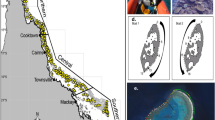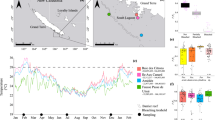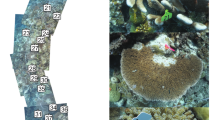Summary
Coral reefs of Middle Norian age are reported from Rangring, the Pin-Spiti confluence, Kiomo, Latarse (all Spiti), and Pamachen, Hangrang Pass and Tapuk (Kinnaur). All these reefs are rather small (up to 30 m thick) and form a low-angle contact with the underlying beds. The Rangring and Pin-Spiti Reefs were studied with regard to microfacies, biocommunities and facies interpretation.
The Rangring Reef is characterized by Wacke/Floatstones with whole fossils, Pack/Wackestones, and Boundstones. Main reef builders are calcisponges (Colo spongia catenulata OTT), corals (Montlivaltia, Stylophyllopsis, Thamnasteria rectilamellosa) tabulozoans and hydrozoans (Spongiomorpha ramosa) andPycnoporidium? eomesozoicum. This reef structure probably represents a reef formed on the lower part of a slope.
The Pin-Spiti Confluence Reef exhibits a vertical zonation. The facies types are represented by Boundstones, Oolithic Pack/Wackestones, Bioclastic Float/Wackestones, Oncolithic Packstones and Wackestones as well as Boundstones. The Oncolithic Pack/Wackestone Facies surrounds theThecosmilia cyclica—Framestone Facies. Both facies types are strongly interfingered. Major reef building organisms areColospongia catenulata, Paradeningeria, Dictyocoelia, Peronidella, Thecosmilia cyclica, Thamnasteria rectilamellosa, Seriastreea multiphyllia, andSpongiomorpha ramosa. The Pin-Spiti Reef probably represents a patch reef formed in a wide reef area of moderate energy, with some protected parts.
The microfacies of the Latarse Reef points to a slope/reef flank position. The Kiomo Reef probably grew within a lagoonal environment.
Boundstones, Oncoid/Ooid Wackestone/Packstones and Bioclastic Grainstones characterize the Hangrang and the Tapuk Reefs which yield communities withThecosmilia cyclica, Thecosmilia clathrata, Stylophyllopsis, Stromatomorpha rhaetica and chaetetids. Both reefs represent high-energy marginal parts of a major reef crest.
The composition and the distribution of the Spiti-Kinnaur reefs are comparable to a carbonate platform bordered by knoll reefs.
The reef-building communities are very similar to those of Norian and Rhaetian reefs from the Northern Alps.
Similar content being viewed by others
References
ARTHABER, G. (1906): Die alpine Trias des Mediterran-Gebietes.—Lethaea geognostica,2, Das Mesozoicum, Band 1, Trias, Stuttgart
BASSI, U.K., CHOPRA, S. & DATTA, B.M. (1983): A new Phanerozoic Basin in Kinnaur, Himachal Himalaya.—J. Geol. Soc. India,24/6, 281–290, Bangalore
BERTHELSEN, A. (1951): A geological section through the Himalaya.—Medd. Dansk. Geol. Foren.,12, 102–104, Copenhagen
— (1953): On the geology of Rupshu District, N.W. Himalaya.—Medd. Dansk. Geol. Foren.,12/3, 350–414, Copenhagen
BHARGAVA, O.H. & KATHIARA, R.S. (1969):Montlivaltia sp. from the Triassic of Spiti.—Bull. Indian Geol. Assoc.2, 123, Chandigarh
DIENER, C. (1908): Ladinic, Carnic and Noric faunae of Spiti.—Paleont. Indica, Ser. 15,5/3, 1–157, Calcutta
— (1912): The Trias of the Himalayas.—Mem. Geol. Surv. India,36/3, 1–159, Calcutta
DRONOV, V.I., GAZDZICKI, A. & MELINIKOVA, G.K. (1982): Upper Triassic Reefs in the Southeastern Pamir Range.—Facies,6, 107–128, Erlangen
DULLO, W.C. (1980a): Paläontologie, Fazies und Geochemie der Dachsteinkalke (Ober-Trias) im Südwestlichen Gesäuse, Steiermark, Österreich.—Facies,2, 55–122, Erlangen
DUNHAM, R.J. (1962): Classification of Carbonate rocks according to depositional texture.—Mem. Amer. Ass. Petrol. Geol.,1, 108–121, Tulsa
EMBRY, A.F. & KLOVAN, J.E. (1972): Absolute water depth limits of late Devonian Paleocological zones.—Geol. Rdsch.61/2, 672–686, Stuttgart
FLÜGEL, E. (1981): Paleoecology and facies of Upper Triassic Reefs in the Northern Calcareous Alps.—Soc. Econ. Palaeont. Min., Spec. Publ.,30, 291–359, Tulsa
— (1982a): Evolution of Triassic Reefs: Current Concepts and Problems.—Facies,6, 297–328, Erlangen
— (1982b): Microfacies Analysis of Limestones.—633 pp., Berlin-Heidelberg-New York (Springer)
FRECH, F. (1903–1908): Das Mesozoicum. 1. Band: Trias.—Lethaea geognosica, Teil II, Stuttgart (Schweizerbart)
FUCHS, G. (1979): On the Geology of Western Ladakh.—Jahrbuch Geol. Bundesanst.,122, 513–540, 8 pls., 5 figs., Wien
— (1982): The Geology of the Pin Valley in Spiti, H. P., India.—Jahrbuch Geol. Bundesanstalt,124/2, 325–359, 3 pls., 21 figs., Wien
GUPTA, V.J. (1983): Triassic Conodonts from Ladakh and Spiti.—Schriftenreihe Erdwiss. Komm., Österr. Akad. Wiss.,5, 83–92, 6 pls., Wien
HAYDEN, H.H. (1904): The geology of Spiti with parts of Bashar and Rupshu.—Mem. Geol. Surv. India,36, 1–129, Calcutta
KOHLI, G. & SHUKLA, B.N. (1954): In: General Report, 1952, Spiti Kangra.—Rec. Geol. Surv. India,86/1, 23–25, Calcutta
KRISTAN-TOLLMANN, E. & TOLLMANN, A. (1982): Die Entwicklung der Tethystrias und Herkunft ihrer Fauna.—Geol. Rundschau,71, 987–1049, 2 figs., Stuttgart
—&— (1983): Überregionale Züge der Tethys in Schichtfolge und Fauna am Beispiel der Trias zwischen Europa und Fernost, speziell China.—Schriftenreihe Erdwiss. Komm., Österr. Akad. Wiss.,5, 177–230, 14 pls., 10 figs., Wien
PASCOE, E.H. (1968): A Manual of the Geology of India and Burma.—2, 485–1338, Government of India Press, Calcutta
PICKETT, J.W., JELL, J.S., CONAGHAN, P.J. & Mc POWELL, C.A. (1975): Jurassic Invertebrates from the Himalayan Central Gneiss.—Alcheringa,1, 71–85
PILLER, W.E. (1981): The Steinplatte Reef Complex, part of an Upper Triassic Carbonate Platform near Salzburg, Austria.—Soc. Econ. Palaeont. Min., Spec. Publ.,30, 261–290, Tulsa
SCHÄFER, P. (1979): Fazielle Entwicklung und Palökologische Zonierung zweier obertriadischer Riffstrukturen in den Nördlichen Kalkalpen (Oberrhät-Riff-Kalke, Salzburg).—Facies,1, 3–245, Erlangen
SRIKANTIA, S.V. (1981): The lithostratigraphy, sedimentation and structure of Proterozoic-Phanerozoic Formations of Spiti Basin in the Higher Himalaya of Himachal Pradesh, India.—Contemporary Geosci. Res. Himalaya,1, 31–48, Dehra Dun
TERRA, D.H. (1935): Geological Studies in the North-West Himalaya between the Kashmir and the Indus Valleys.—Mem. Connecticut Acad. Arts Sci.,8, 18–76
WILSON, J.L. (1974): Characteristics of Carbonate Platform Margins.—Bull. Amer. Assoc. Petrol. Geol.,58, 810–824, Tulsa
— (1975): Carbonate Facies in Geological History.—471 pp. Berlin-Heidelberg-New York (Springer)
WURM, D. (1982): Microfacies, Paleontology and Paleoecology of the Dachstein Reef Limestones (Norian) of the Gosaukamm Range, Austria.—Facies,6, 203–296, Erlangen
Author information
Authors and Affiliations
Rights and permissions
About this article
Cite this article
Bhargava, O.N., Bassi, U.K. Upper triassic coral knoll reefs: Middle Norian, Spiti-Kinnaur, Himachal Himalaya, India. Facies 12, 219–241 (1985). https://doi.org/10.1007/BF02536980
Issue Date:
DOI: https://doi.org/10.1007/BF02536980




